
Concept explainers
(a)
To approximate: the limit by using a graphing utility to graph the function..
(a)
Explanation of Solution
Given information:
Given following limit
Calculation:
Let
To calculate the model using the T1-83 graphing calculator follows the steps:
Press
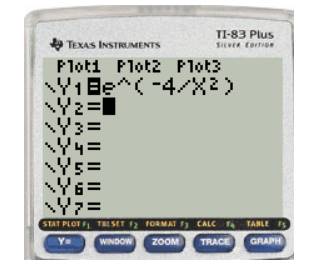
Press ZOOM and choose the appropriate zoom function, then plot window is like this
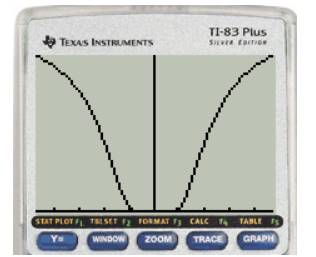
From the graph we can see that the function converges to a single bounded values as it approaches 0 both from left and right side.
(b)
To approximate: the limit by using the table feature of the graphing utility to create a table.
(b)
Answer to Problem 40RE
Limit converages to a value of 0.
Explanation of Solution
Calculation:
Numerically approximate the limit using
Press Y= and enter the equation
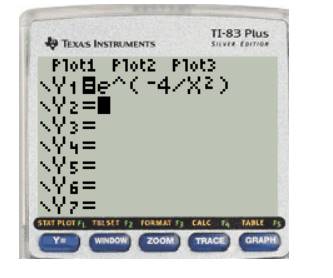
Press
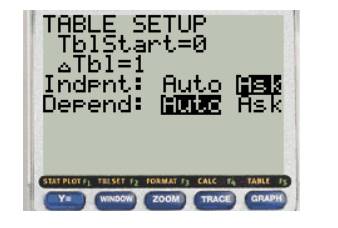
Press
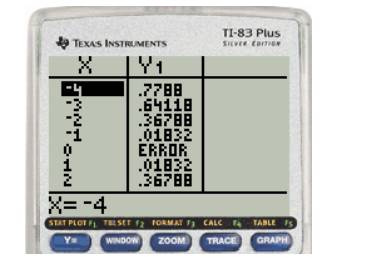
Limit converages to a value of 0
Chapter 12 Solutions
Precalculus with Limits
- For this question, refer to the a1q4.py Python code that follows the assignment, as well as the dataprovided after the assignment.(a) Modify the code presented to plot the data from the two separate sets of information(from each region).(b) For each population of squirbos, let ` be the length of their front claws and s the mass ofthe skull. Determine for what value of m the s is isometric to `m. Justify it with your log − log plotsfrom (a) and suitable sketched lines.(c) What do you notice about the correlus striatus on your plot?(d) What historically might explain their situation?arrow_forwardPlease see image for question.arrow_forwardQuestion 2 Find the shortest distance between the lines [x, y, z] = [1,0,4] + t[1, 3, −1] and [x, y, z] = [0,2,0] + s[2, 1, 1]. [Do not use derivatives.]arrow_forward
- Please see image for the questions.arrow_forwardUse the following graphs to evaluate the given one-sided limit. Answer exactly. y = f (x): y = g(x): 8 6 ν -8-6-4-2 2- 1-2-2 -4 -6 -8 ° 4 lim (f(x)+g(x)) = x+2+ 8 6 2 ν 0 x x 6 8 -8 -6-4-2 2 6 8 -2 -4 -6 -8arrow_forwardQuestion 1 The points A = (-2, 3, 2) and B = (4, 1, 4) are reflections of one another in a plane S. Find an equation for S.arrow_forward
- The graph below is the function f (x) -D -3-2 4 3 2 Q2 03 Find lim f(x) = x-1- Find lim f(x) = x−1+ Find lim f(x) = x-1 Find f (-1) = 3 4 5arrow_forwardi circled the correct answer and i did most of the question but i cant figure out how to add both residues to get the correct answer could you please show me how to do itarrow_forwardQuestion 3 Starting at the point (0, −2,0), I walk up the hill z = 4-x² — y². The projection of my path on the xy plane is the line y = 2x-2. (a) At what point on my path is my altitude (the z-value) the greatest? (b) What is the slope m of my path (taking the z-axis to be vertical) when I am at the point (1, 0, 3)? [Hint: Parametrize my path (take x to be t).]arrow_forward
- I circled the correct, could you explain using stokearrow_forwardUse Euler's method to numerically integrate dy dx -2x+12x² - 20x +8.5 from x=0 to x=4 with a step size of 0.5. The initial condition at x=0 is y=1. Recall that the exact solution is given by y = -0.5x+4x³- 10x² + 8.5x+1arrow_forwardFind an equation of the line tangent to the graph of f(x) = (5x-9)(x+4) at (2,6).arrow_forward
 Calculus: Early TranscendentalsCalculusISBN:9781285741550Author:James StewartPublisher:Cengage Learning
Calculus: Early TranscendentalsCalculusISBN:9781285741550Author:James StewartPublisher:Cengage Learning Thomas' Calculus (14th Edition)CalculusISBN:9780134438986Author:Joel R. Hass, Christopher E. Heil, Maurice D. WeirPublisher:PEARSON
Thomas' Calculus (14th Edition)CalculusISBN:9780134438986Author:Joel R. Hass, Christopher E. Heil, Maurice D. WeirPublisher:PEARSON Calculus: Early Transcendentals (3rd Edition)CalculusISBN:9780134763644Author:William L. Briggs, Lyle Cochran, Bernard Gillett, Eric SchulzPublisher:PEARSON
Calculus: Early Transcendentals (3rd Edition)CalculusISBN:9780134763644Author:William L. Briggs, Lyle Cochran, Bernard Gillett, Eric SchulzPublisher:PEARSON Calculus: Early TranscendentalsCalculusISBN:9781319050740Author:Jon Rogawski, Colin Adams, Robert FranzosaPublisher:W. H. Freeman
Calculus: Early TranscendentalsCalculusISBN:9781319050740Author:Jon Rogawski, Colin Adams, Robert FranzosaPublisher:W. H. Freeman
 Calculus: Early Transcendental FunctionsCalculusISBN:9781337552516Author:Ron Larson, Bruce H. EdwardsPublisher:Cengage Learning
Calculus: Early Transcendental FunctionsCalculusISBN:9781337552516Author:Ron Larson, Bruce H. EdwardsPublisher:Cengage Learning





